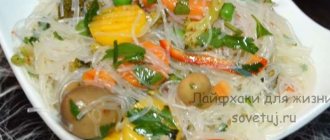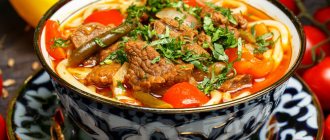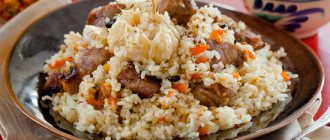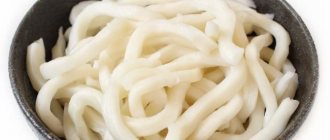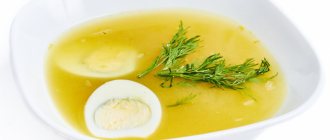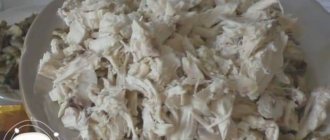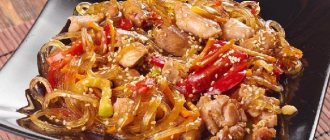Preparation
- How to prepare wok noodles with chicken and vegetables, the recipe for which will be discussed below? First of all, you need to prepare all products for use. The chicken and vegetables are washed well and dried on a paper towel.
- First, the carrots are cut into cubes, then the onions are cut into half rings, bell peppers and chicken are cut into strips.
- If you use frozen broccoli, then after defrosting it, it should be divided into inflorescences. But when it is fresh, you first need to dip it in boiling, slightly salted water for a couple of minutes.
- Thoroughly peel the chili pepper and garlic and chop it as finely as possible.
- Any vegetable oil is poured into a special frying pan, the main thing is that it is odorless. When it warms up, add garlic and hot peppers so that they fry a little.
- At this time, pour water into a separate pan, throw in the noodles, and place on the stove. Having done this, chicken and carrots are laid out in the frying pan. Over high heat, stirring constantly, they should fry until lightly browned.
- After this, broccoli, bell pepper and onion are added. Everything is mixed well and fried for 8 minutes.
- During this time the noodles should be cooked. It drains into a colander and goes into the frying pan. Immediately more wok sauce is added. All components are thoroughly mixed and heated for several minutes.
- At the end of cooking, the contents of the pan are seasoned with sesame oil. You shouldn't add a lot of it. Afterwards, the pan with the finished dish can be removed from the hot surface.
- Wok noodles with chicken and vegetables served with chopped green onions. It is sprinkled with cilantro on top.
Cooking
22.11.2016
The hallmark of Chinese cuisine and Asian cooking in general are wok dishes. To cook them you need a special wok pan. This is the dish we will talk about.
It has a round shape, a convex bottom, high and thin walls. It is made of cast iron or carbon steel and has one wooden handle.
In China, they often cook on special burners, in the center of which there is a semicircle-shaped recess. With its help, the wok becomes stable, and a powerful flame quickly and evenly heats the walls.
“European” wok is being produced for home kitchens
with a flat bottom. This wok is suitable for conventional gas and induction cookers. On the market, such pans are mainly made of non-stick steel, aluminum or stainless steel. Available with one or two handles.
The answer is simple. Cooking in a wok usually takes less than 15 minutes, resulting in:
- Useful
. Products lose almost no vitamins and nutrients with such rapid heat treatment. Food cooked in a wok is healthier than in a regular frying pan, since the ingredients are fried for 1-3 minutes; - Not fat
. A tablespoon of oil is enough for frying, and the process itself takes minutes; - Crispy and flavorful
. Meat and vegetables, when quickly fried, acquire a dense crispy crust and an appetizing appearance.
A wok is a universal kitchen assistant.
pan is mainly used for quick frying - stir-fry.
(from English “fry and stir”), but you can also:
- simmer meat and vegetables
, covered with a lid; - Use for deep frying
; - Use as a steamer.
using a special grid; - Make soup.
A wok can easily replace a regular frying pan, saucepan or small saucepan.
Wok noodles: types
Among the existing options for this dish, there are several of the most common. Anyone who has ever tried Chinese cuisine is probably familiar with egg noodles. This is a traditional side dish in China, which has a rich taste and is used in combination with vegetables, fish, and meat. Visually, such noodles often have a yellow tint.
Also popular is Udon, which is visually much thicker than other types. These noodles are prepared using flour, salt and water. Thanks to this, the side dish does not have a clearly defined taste and stands out:
- excellent combination with different sauces; - the ability to eat both hot and cold; - Serve with broth.
Soba noodles are also on the list of famous ones. This variation is made from buckwheat flour, which surprises with its nutty taste. If you are tired of classic noodles, then it’s time to get acquainted with this food option.
Popular varieties of this dish also include spinach and soy noodles. The first option, as the name suggests, is made from spinach and is fully loaded with this flavor. The second is prepared using starch, which is previously extracted from soybeans. The taste of soy, accordingly, predominates.
Cast iron, aluminum, ceramic and steel wok. Pros and cons of materials
Among the cookware products on the market, the following woks can be distinguished.
pros
- Durability
- Strength
- Can cook on gas, electric stove and open fire
- Not afraid of high heating temperatures
- Good wear resistance, difficult to scratch
Minuses
- Heavy
- Takes a long time to heat up
- After each cooking, immediately wash and wipe with a dry cloth.
- It will rust if you leave the pan in water for a long time.
- Do not leave food in a cast iron frying pan
- With prolonged contact with products, without cleaning, the metal absorbs their odor
When frying, the surface of the cast iron wok heats up evenly and completely. The roasting is smooth and fast. Cast iron woks are also used for stewing meat and vegetables, preparing stews, and also for cooking broths.
Aluminum wok with non-stick coating
pros
- Lungs
- Heats up quickly
- Relatively inexpensive
Minuses
- Non-stick coating wears out quickly
- At high temperatures, non-stick coating can release harmful substances into food
Ceramic wok
pros
- The surface of the pan is smooth
- Fast heating
- The smell of food does not penetrate into the ceramic structure
- Can be cooked on a gas or electric stove
Minuses
- High price
- The material is susceptible to temperature changes.
- Fragility
pros
- Durable. When started correctly, a non-stick coating is formed
- Lungs
- Heats up quickly and cools down just as quickly
- Flat bottom steel woks can be used on gas, electric and induction hobs and open fires
Minuses
- Wall deformation is possible due to high temperature if very thin or cheap steel is used
- Without the first “opening of the wok”, the pan coating has low non-stick properties, food will stick and burn during frying.
- A good steel wok can cost a lot
- There are woks on sale with non-stick coatings, which can release harmful substances when heated too much.
It is steel woks that have become most widespread throughout the world. They are most often used for preparing wok dishes. I’ll write below about the “discovery” of a steel wok or its first use.
How to “open” wok correctly? First use of a cast iron or steel wok
Before first use
To prevent food from sticking to the walls and burning, you need to apply
a protective non-stick coating
. To do this, the wok needs to be “opened” or as the Chinese call this process “hoi wok”.
There are more than 10 methods of opening. I will give an example of one method for use at home.
How to choose a wog (Chinese frying pan). 2-minute video in Russian.
To make your wok serve you as long as possible:
- Gas stove or burner
- Carbon steel wok without non-stick coating
- Refined sunflower oil
- Paper towels or napkins
Preparation:
- First, thoroughly wash the wok to remove any shipping grease, dust or other contaminants.
- After washing, you can boil water in a wok to be sure to remove any dirt from the inside of the pan.
- The wok should not be greasy to the touch.
- Open the window in the kitchen and close the door to another room. Turn on the hood, if available. There will be a lot of smoke.
And the process itself:
- A clean wok is set to maximum flame. After some time, the metal will heat up and the color at the bottom will change. The color will shift to blue in the hottest areas.
- Slowly turning and tilting the wok around the flame, let its walls also heat up.
- After most of the surface has warmed up and taken on a blue tint, it’s time to add 80-120 ml of sunflower oil. The oil should cover the bottom in an even layer.
- Rotate the wok, tilting it to the sides so that the oil covers the entire area of the pan.
- When rotating, do not move the wok far from the flame. The pan should not cool down.
- After 2-3 minutes, turn off the heat.
- After 2-3 minutes, move the wok to the sink and cool first the outer part of the pan, and then the inside under cold water
- After cooling, turn the flame back to maximum.
- Heat the wok until the moisture evaporates.
- After this, add 30-50 ml of oil, spread it over the surface of the wok and heat until smoke appears.
- Turn off the flame.
- Take napkins or paper towels and, using a metal pot holder or other tools, lightly rub the oil into the inside of the wok. You can also go through the outside, this will protect the steel from corrosion in the future.
- Let the pan cool by leaving it on the stove
After creating this coating, do not wash the wok with detergents.
! Now only warm water, a new sponge or brush. The wok should always remain covered in a film of oil. This way the frying pan will serve you for many years.
If you did not temper the steel wok right away, you can do this later by cleaning the surface of the pan and repeating the steps above.
Detailed launch of the wok in the video in Russian. The blog is beautiful and tasty
A shorter way to prepare a wok in this video. Here they use a torch, oil and paper towels.
Most often, a wok is used for cooking food using the method of quick frying with constant stirring, which is called stir-fry (stir-fry from English “fry and stir”).
There is nothing complicated in this method, but in order for the wok dishes to turn out crispy, appetizing, aromatic and not burn, you must follow the following rules
:
How to properly fry meat in a wok?
I would especially like to focus on the preparation of meat ingredients.
What to cook in a wok pan? Wok noodle recipes
So, we figured out what a wok is for, what it comes in, how to prepare it and how to cook with it.
Now the fun part is what to cook in a wok.
I purchased this dish not so long ago, but I have already tried it in action with the recipe “ Funchose with vegetables and meat in teriyaki sauce
" To go to step-by-step recipes, click on the names.
The following recipes are also suitable for cooking in a wok pan.
Peel the garlic and ginger. Three on a fine grater. Take a wok and put it on fire. Pour 3 tbsp into it. spoons of sesame oil. Fry the garlic and ginger over high heat for 1-2 minutes. They will add flavor to the oil in which the chicken will be fried.
The chicken fillet needs to be washed and dried a little. Cut it with a sharp knife into small, rather narrow slices. The size of the pieces should be such that they can later be conveniently picked up with chopsticks. Fry the chicken in a wok with garlic and ginger. You can add salt to the chicken if desired, although I prefer to use just soy sauce.
While the chicken is roasting, prepare the remaining vegetables. Bell peppers need to be washed and cut. It is better to take peppers of different colors. This way the dish will look more aesthetically pleasing. Cut the bell pepper into half rings, removing the seeds. Remove the cooked chicken from the wok. Fry the pepper.
Wash a bunch of green onions. We chop it not too finely, but not too coarsely. Fry the onion with stewed pepper. Then put the chicken back in. Add cashew nuts. They can be crushed or put whole. Add pepper and salt.
I pre-boiled the noodles in a separate bowl. By the way, if you are in doubt which one to use for this dish, take a thin one and a wide one, you won’t go wrong. The noodles do not need to be cooked for long. It should be springy, but not soggy. I transfer the noodles to the wok.
Asian dishes have long become popular all over the world. It’s no longer possible to surprise anyone with homemade rolls and sushi. Noodles are sometimes undeservedly deprived of attention, suggesting that rather specific products and spices are used for them. But this is not entirely true, and there are recipes that use products that are easily available to residents of any fairly large settlement.
The name of noodles - Wok - has become established in European and Russian traditions thanks to restaurants and shops specializing in Chinese cuisine. But initially this is the name of a deep frying pan, in which almost all dishes are prepared in China.
Noodles are also served in deep, small-diameter cups. Of course, the traditional utensils for Chinese noodles are wooden sticks. But at home, you can easily limit yourself to ordinary forks, unless you are planning a Chinese-style themed evening.
Step by step recipe
This recipe uses chicken, so the dish is not heavy and is suitable for dinner.
We follow everything exactly according to the recipe for cooking Wok noodles with chicken:
- put a frying pan with oil on the stove (you need to set the temperature to medium), also turn on another section at the same temperature and place a pan of water on it;
- wash the breast, blot it with a napkin to dry it, cut it into pieces (rather small);
- cut the pepper, tomato into cubes, finely chop the onion and champignons, if they are whole;
- Place noodles in boiling water in a saucepan and cook for 7-10 minutes (you can use the instructions on the package);
- Place vegetables, mushrooms and meat into heated oil;
- after the chicken pieces are covered with a slightly golden crust, you need to fry them in a frying pan for another 5-7 minutes;
- salt or (which is more consistent with the Chinese tradition) pour soy sauce over the meat and vegetables in a frying pan;
- drain the water from the noodles, pour it into a colander, and then into the frying pan;
- stir, add parsley, cook for another 3-4 minutes;
- Sprinkle the finished dish with finely chopped green onions in a plate.
Wok noodles with chicken and vegetables
The more vegetables are used in the recipe, the healthier and more nutritious the dish will be.
Products:
- 100 g rice or buckwheat noodles;
- 4 cloves of garlic;
- 250 g chicken breasts;
- 3 tbsp. soy sauce;
- 0.5 pcs. carrots (small) and onions;
- 1 tbsp. ginger (root, not powder);
- 1 tbsp. squeezed lime juice;
- 70 g bean pods;
- 20 g green Luke;
- 1 tsp starch;
- 0.5 tbsp. rast. oil (possibly sesame oil, if you can get it);
- 10 g each of cilantro and coriander.
Cooking time: 30 min.
Calorie content per 100 g: 90 kcal.
Place water on the stove in which the noodles will boil. Then finely chop the garlic and ginger. Vegetables are cut into strips.
It is also better to cut the meat into long small pieces. Pour the sauce over the chicken in a deep bowl, add garlic, ginger, and lime juice. Cut green onions into long thin strips.
Place a deep frying pan with oil on the stove (at medium temperature). If the water has already boiled, add the noodles.
Place the chicken in a heated frying pan, fry a little, then add the carrots and stir. Now add the beans, mix again and add the onion. If there is too much liquid in the pan, add starch. Stirring, cook for 5 minutes.
When the noodles are ready, transfer them to a colander and then put them in a frying pan. All products are mixed and fried for another 2 minutes.
If the dish doesn’t seem spicy enough, you can pour in a little more of the mixture of sauce, ginger, and lime juice left after transferring the chicken to the pan.
Wok with chicken vegetables and noodles
Popular now:
Simple, easy, quick salads, Chicken salad, Caesar salad, Egg salad, Crab salad, Crab stick salads, Mushroom salads, Birthday salads, Greek salad, VinaigrettePies, Homemade cookies, Pies, Pancakes, Pancakes and crepes, Cheesecakes, Buns, Charlotte, Pastries, Mannik - semolina pie, Donuts, Cupcakes, muffins, cupcakes, Flatbreads, Draniki, Khachapuri, Kefir pancakes, Cupcakes, Cheesecake, Charlotte with apples, Muffins, Pie with strawberries, Cheesecakes . , Pilaf, Dumplings, Curd casserole, Omelette, scrambled eggs, Steaks, Pizza, Stuffed cabbage, Stew, Lasagne, Meatballs, Pasties with and without meat, In batter, Goulash, Chops, Porridge with milk, Chicken cutlets, French-style meat in the oven , Chicken in sauce, Lagman, Stewed cabbage, Vegetable stew, Semolina porridge, Millet porridge, Rice porridge, Fish cutlets, Porridge on water, Curd casserole in the oven, Potato casserole Kebabs, Pork kebabs, Chicken skewers Glaze for cakes and pastries Yeast dough, Pizza dough, Pie dough, Kefir doughEaster cakes, Birthday gravies, Chicken sauce, Creamy sauceDiet recipes for weight loss, Dietary recipes
Quick Asian dish. Can you cook dinner in minutes?! Chicken, vegetables and noodles in a wok pan are an Asian classic for a hearty yet light lunch or dinner.
Everything is prepared extremely simply and incredibly quickly, and the combination of flavors gives you a good mood and a charge of creative thoughts on what else to add next time.
- Place water on the stove for the noodles.
- Finely chop the chili pepper. It turns out spicy. If you don't like it spicy, reduce the amount of pepper.
- Peel and finely chop the garlic (3 cloves).
- Wash, dry and cut the chicken fillet into long strips. Add pepper, garlic, soy and oyster sauces to it.
- Peel the carrots and cut into cubes.
- Wash the green beans and cut them in half or into 3 parts.
- Peel the onion and cut into thick strips.
- Chop the ginger.
- Roll the lime over the table, pressing down slightly (so more juice will flow out of it) and cut lengthwise (for the same purpose).
- Add ginger to the chicken and add lime juice.
- Wash the green onions and chop them like other vegetables.
- Heat up the wok. Put oil and a clove of garlic in there.
- When the water boils, put the noodles in it. Cook according to the instructions on the package (sometimes it is enough to put it in boiling water and not cook).
- Place the chicken in the wok. Fry a little. If there is a lot of liquid, add a little starch.
- After a minute, add the beans.
- After another minute - carrots. Don't forget to stir constantly.
- And onions.
- If there is any left over from the chicken, chili pepper. Fry, stirring.
- Check the noodles for doneness.
- Drain in a colander and rinse well.
- Add sesame oil and soy sauce if desired. Coarsely chop the cilantro and place in the wok. Mix.
- Place the noodles in the wok, add salt and pepper. Fry it a little.
Serve the chicken with vegetables and noodles with a drizzle of oil and a pinch of pepper. Bon appetit!
How to cook spaghetti correctly
You will need a saucepan that has a wide bottom. Add water in a ratio of 1:10, 10 grams of salt per liter of water will be enough. To submerge the spaghetti in the water, press gently on it at the beginning of cooking.…
To prevent pasta from sticking together
Immediately after cooking, the pasta should be mixed with melted butter so that it does not stick together.
To prevent pasta from sticking together when cooking
To prevent the paste from sticking together, you need to add either 40 ml to the water (2.5 liters). lemon juice, or 1 tbsp. a spoonful of vinegar. The acid prevents the starch contained in the paste from disintegrating too much in the water.
To prevent the formation of smoke during frying...
To prevent the formation of smoke when frying vegetables, meat or fish, do not add cold vegetable oil to the pan. Mixing with hot water, it creates fumes.
To keep the beef juicy...
If you want to get a juicy piece of roast beef, you first need to fry a whole piece of beef in a small amount of oil or fat so that a crust appears on its entire surface. After the beef you can...
How to get very tender beef?
If large pieces of beef are first fried in a frying pan in a small amount of oil so that a golden brown crust forms on the entire surface, and then baked in the oven, the beef will be…
How to cook tender liver?
As you know, fried liver is very easy to overcook and become hard and unpleasant to the taste. To avoid this, lightly beat the liver on both sides before cooking. And then fry so that...
- Carrots – 33 kcal/100g
- Boiled carrots – 25 kcal/100g
- Dried carrots – 275 kcal/100g
- Garlic – 143 kcal/100g
- Ginger – 80 kcal/100g
- Pickled ginger – 51 kcal/100g
- Dry ginger – 347 kcal/100g
- Dried ground cilantro – 216 kcal/100g
- Cilantro, coriander – 25 kcal/100g
- Coriander – 25 kcal/100g
- Soy sauce – 51 kcal/100g
- Starch – 320 kcal/100g
- Hot chilli pepper – 40 kcal/100g
- Green onion – 19 kcal/100g
- Salt – 0 kcal/100g
- Onions – 41 kcal/100g
- Green beans – 24 kcal/100g
- Chicken breast – 113 kcal/100g
- Pepper – 26 kcal/100g
- Rice noodles – 109 kcal/100g
- Lime juice – 10 kcal/100g
- Sesame oil – 899 kcal/100g
- Oyster sauce – 121 kcal/100g
Calorie content of foods: Hot peppers, Garlic, Chicken breasts, Soy sauce, Oyster sauce, Carrots, Green beans, Onions, Ginger, Lime juice, Green onions, Rice noodles, Starch, Sesame oil, Cilantro, coriander, Salt, Pepper
Source: https://1000.menu/cooking/16804-vok-s-kuricei-ovoshchami-i-lapshoi
Chinese noodles with chicken in teriyaki sauce
Teriyaki is a very popular Chinese sauce. It can be easily found in almost any store. Consider the recipe for Wok noodles with chicken and teriyaki.
Products:
- 1 chicken breast;
- 150g udon noodles, buckwheat or egg;
- 1 piece each carrots, zucchini, pepper;
- 3 cloves of garlic;
- 10 tbsp. teriyaki;
- 2 tbsp. rast. oil (any);
- 1-2 tbsp. sesame
It will take you 40 minutes to prepare.
Calorie content per 100 g: 129 kcal.
Garlic needs to be crushed, pour 3 tbsp in a deep plate. sauce. Place the breast pieces there so that they marinate a little. Put the water for the noodles on the fire. Zucchini, carrots and peppers are cut into bars.
Throw the noodles into boiling water and cook according to the instructions on the package. Heat the oil in a frying pan and add the meat there. After 3-4 minutes, add the vegetables, stir, and fry for 7 minutes.
Transfer the noodles from the colander to the frying pan, stir, and pour in the remaining sauce. After a minute, turn off the stove, remove the frying pan, and sprinkle sesame seeds on top.
Recipe option with beans
This recipe is very simple and contains a minimal amount of ingredients, which does not prevent it from being tasty and satisfying. Another type of Asian noodle is used here - funchose. It has a rather original appearance and taste, slightly reminiscent of seaweed.
Products:
- 400 g funchose noodles;
- 100 g chicken breasts;
- 50 ml soy sauce;
- 200 g bean pods;
- 1 onion;
- 2 tbsp each sugar (white) and vegetable matter. oils
The cooking process takes: 20 minutes.
Calorie content per 100 g: 134 kcal.
The washed and dried meat is cut into oblong pieces. The beans are cut into two or three parts (each pod). If it is frozen, then you need to defrost the pods in advance. Onions are cut into feathers.
Heat the oil in a frying pan, fry the chicken in it for about 3 minutes, then add the onion, fry for another 2 minutes, add vegetables. Prepare noodles according to package directions. Usually, funchose is simply poured with boiling water from a kettle for a certain time, since it is very thin and will not withstand cooking.
Pour the sauce into the pan and fry, stirring all the time, for 7-8 minutes. Pour the funchose in there (you need to drain all the water first), mix well and set aside from the stove. It is better to allow 5 minutes to pass before serving, then the noodles will be well soaked in the sauce.
To get a real Asian feast, you need to harmoniously select other dishes and drinks to go with the noodles. Usually, a few minutes after a meal, the Chinese drink green tea (drinking it on an empty stomach is not recommended).
For starters, you can try making traditional soup with seaweed and a piece of fish or vegetable broth. The right choice of products will help you appreciate Asian cuisine and enjoy your meal.
Wok noodles are a nourishing and vitamin-rich dish that is gaining popularity due to the variety of dietary recipes and minimal cooking time. Previously, it was cooked in a wok, which had a hemispherical shape.
At home, a frying pan with high sides and a non-stick coating will suffice. 5 best recipes will tell you how to cook a wok and make the dish incomparable!
Wok rice noodles with vegetables and mushrooms
The recipe will appeal to diet lovers. Vegetables wok calorie content: 207.2 kcal
You will need:
- 150 g rice noodles
- 250 gr. champignons
- 1 PC. large bell pepper
- 1 PC. chili pepper
- 1 PC. zucchini
- 0.5 tsp dry ginger
- 2-3 teeth. garlic
- 6 tbsp. soy sauce
- 2 tbsp. oyster sauce (can be replaced with balsamic)
- 1 tbsp. vinegar
- 1 tbsp brown sugar
- 4 tbsp vegetable oil
- 2 tbsp sesame seeds
- 1 bunch of greens to taste (cilantro, parsley, green onions) salt - to taste
Cooking process:
- We clean the chili (from seeds) and champignons. Cut vegetables into thin strips, mushrooms into slices.
- Pour boiling water over the rice noodles with the addition of 1 tablespoon of vegetable oil. Leave for 7 minutes, stirring every 1-2 minutes to separate. After a while, the water needs to be drained. PS Olive or sesame oils are ideal.
- In a deep bowl, mix soy sauce, oyster sauce, vinegar and sugar. Add ginger and garlic through a garlic press.
- Add chopped vegetables and stir.
- Heat the frying pan well, add 3 tablespoons of vegetable oil. Over high heat, fry the vegetables in the sauce and sesame seeds for 3 minutes, stirring constantly.
- Add the noodles and fry everything together for another 3-5 minutes.
- The dish is ready! Serve seasoned with your favorite herbs.
Recipe: Noodles with wok vegetables. Calorie, chemical composition and nutritional value.
Nutritional value and chemical composition of “Noodles with wok vegetables”.
The table shows the nutritional content (calories, proteins, fats, carbohydrates, vitamins and minerals) per 100 grams of edible portion.
| Nutrient | Quantity | Norm** | % of the norm in 100 g | % of the norm in 100 kcal | 100% normal |
| Calorie content | 106.7 kcal | 1684 kcal | 6.3% | 5.9% | 1578 g |
| Squirrels | 3.2 g | 76 g | 4.2% | 3.9% | 2375 g |
| Fats | 3 g | 56 g | 5.4% | 5.1% | 1867 |
| Carbohydrates | 16.6 g | 219 g | 7.6% | 7.1% | 1319 g |
| Organic acids | 0.1 g | ~ | |||
| Alimentary fiber | 2 g | 20 g | 10% | 9.4% | 1000 g |
| Water | 72.9 g | 2273 g | 3.2% | 3% | 3118 g |
| Ash | 1.232 g | ~ | |||
| Vitamins | |||||
| Vitamin A, RE | 404.1 mcg | 900 mcg | 44.9% | 42.1% | 223 g |
| beta carotene | 2.427 mg | 5 mg | 48.5% | 45.5% | 206 g |
| Lycopene | 151.406 mcg | ~ | |||
| Lutein + Zeaxanthin | 2.021 mcg | ~ | |||
| Vitamin B1, thiamine | 0.056 mg | 1.5 mg | 3.7% | 3.5% | 2679 g |
| Vitamin B2, riboflavin | 0.043 mg | 1.8 mg | 2.4% | 2.2% | 4186 g |
| Vitamin B4, choline | 5.31 mg | 500 mg | 1.1% | 1% | 9416 g |
| Vitamin B5, pantothenic | 0.141 mg | 5 mg | 2.8% | 2.6% | 3546 g |
| Vitamin B6, pyridoxine | 0.133 mg | 2 mg | 6.7% | 6.3% | 1504 g |
| Vitamin B9, folates | 7.736 mcg | 400 mcg | 1.9% | 1.8% | 5171 g |
| Vitamin C, ascorbic acid | 16.48 mg | 90 mg | 18.3% | 17.2% | 546 g |
| Vitamin E, alpha tocopherol, TE | 1.71 mg | 15 mg | 11.4% | 10.7% | 877 g |
| gamma tocopherol | 0.002 mg | ~ | |||
| Vitamin H, biotin | 0.272 mcg | 50 mcg | 0.5% | 0.5% | 18382 g |
| Vitamin K, phylloquinone | 5.2 mcg | 120 mcg | 4.3% | 4% | 2308 g |
| Vitamin RR, NE | 1.0553 mg | 20 mg | 5.3% | 5% | 1895 |
| Niacin | 0.568 mg | ~ | |||
| Betaine | 0.651 mg | ~ | |||
| Macronutrients | |||||
| Potassium, K | 153.12 mg | 2500 mg | 6.1% | 5.7% | 1633 g |
| Calcium, Ca | 25.44 mg | 1000 mg | 2.5% | 2.3% | 3931 g |
| Silicon, Si | 8.747 mg | 30 mg | 29.2% | 27.4% | 343 g |
| Magnesium, Mg | 20.78 mg | 400 mg | 5.2% | 4.9% | 1925 |
| Sodium, Na | 257.46 mg | 1300 mg | 19.8% | 18.6% | 505 g |
| Sera, S | 12.75 mg | 1000 mg | 1.3% | 1.2% | 7843 g |
| Phosphorus, Ph | 46.6 mg | 800 mg | 5.8% | 5.4% | 1717 g |
| Chlorine, Cl | 18.73 mg | 2300 mg | 0.8% | 0.7% | 12280 g |
| Microelements | |||||
| Aluminium, Al | 120.6 mcg | ~ | |||
| Bor, B | 67.7 mcg | ~ | |||
| Vanadium, V | 18.11 mcg | ~ | |||
| Iron, Fe | 0.871 mg | 18 mg | 4.8% | 4.5% | 2067 g |
| Yod, I | 2.29 mcg | 150 mcg | 1.5% | 1.4% | 6550 g |
| Cobalt, Co | 1.593 mcg | 10 mcg | 15.9% | 14.9% | 628 g |
| Lithium, Li | 14.592 mcg | ~ | |||
| Manganese, Mn | 0.1362 mg | 2 mg | 6.8% | 6.4% | 1468 g |
| Copper, Cu | 56.22 mcg | 1000 mcg | 5.6% | 5.2% | 1779 g |
| Molybdenum, Mo | 4.647 mcg | 70 mcg | 6.6% | 6.2% | 1506 g |
| Nickel, Ni | 3.733 mcg | ~ | |||
| Rubidium, Rb | 80.1 mcg | ~ | |||
| Selenium, Se | 0.376 mcg | 55 mcg | 0.7% | 0.7% | 14628 g |
| Strontium, Sr | 6.32 mcg | ~ | |||
| Titanium, Ti | 0.01 mcg | ~ | |||
| Fluorine, F | 14.83 mcg | 4000 mcg | 0.4% | 0.4% | 26972 g |
| Chromium, Cr | 2.15 mcg | 50 mcg | 4.3% | 4% | 2326 g |
| Zinc, Zn | 0.3222 mg | 12 mg | 2.7% | 2.5% | 3724 g |
| Zirconium, Zr | 0.01 mcg | ~ | |||
| Digestible carbohydrates | |||||
| Starch and dextrins | 12.145 g | ~ | |||
| Mono- and disaccharides (sugars) | 3.8 g | max 100 g | |||
| Glucose (dextrose) | 1.032 g | ~ | |||
| Sucrose | 1.595 g | ~ | |||
| Fructose | 0.791 g | ~ | |||
| Essential amino acids | 0.152 g | ~ | |||
| Arginine* | 0.048 g | ~ | |||
| Valin | 0.03 g | ~ | |||
| Histidine* | 0.012 g | ~ | |||
| Isoleucine | 0.029 g | ~ | |||
| Leucine | 0.04 g | ~ | |||
| Lysine | 0.037 g | ~ | |||
| Methionine | 0.008 g | ~ | |||
| Methionine + Cysteine | 0.011 g | ~ | |||
| Threonine | 0.027 g | ~ | |||
| Tryptophan | 0.009 g | ~ | |||
| Phenylalanine | 0.029 g | ~ | |||
| Phenylalanine+Tyrosine | 0.034 g | ~ | |||
| Nonessential amino acids | 0.22 g | ~ | |||
| Alanin | 0.026 g | ~ | |||
| Aspartic acid | 0.06 g | ~ | |||
| Glycine | 0.022 g | ~ | |||
| Glutamic acid | 0.123 g | ~ | |||
| Proline | 0.023 g | ~ | |||
| Serin | 0.022 g | ~ | |||
| Tyrosine | 0.019 g | ~ | |||
| Cysteine | 0.009 g | ~ | |||
| Sterols (sterols) | |||||
| Phytosterols | 0.502 mg | ~ | |||
| beta sitosterol | 5.715 mg | ~ | |||
| Saturated fatty acids | |||||
| Saturated fatty acids | 0.4 g | max 18.7 g | |||
| 12:0 Lauric | 0.001 g | ~ | |||
| 14:0 Miristinovaya | 0.001 g | ~ | |||
| 16:0 Palmitinaya | 0.177 g | ~ | |||
| 18:0 Stearic | 0.113 g | ~ | |||
| 20:0 Arakhinovaya | 0.008 g | ~ | |||
| 22:0 Begenovaya | 0.018 g | ~ | |||
| Monounsaturated fatty acids | 0.669 g | min 16.8 g | 4% | 3.7% | |
| 16:1 Palmitoleic | 0.001 g | ~ | |||
| 18:1 Oleic (omega-9) | 0.669 g | ~ | |||
| Polyunsaturated fatty acids | 1.742 g | from 11.2 to 20.6 g | 15.6% | 14.6% | |
| 18:2 Linolevaya | 1.61 g | ~ | |||
| 18:3 Linolenic | 0.002 g | ~ | |||
| Omega-6 fatty acids | 1.6 g | from 4.7 to 16.8 g | 34% | 31.9% |
The energy value of wok noodles with vegetables is 106.7 kcal.
Primary Source: Created in the application by the user. Read more.
** This table shows the average levels of vitamins and minerals for an adult. If you want to know the norms taking into account your gender, age and other factors, then use the “My Healthy Diet” application.
Wok with rice and vegetables
You will need:
- 150 gr. long grain rice (such as basmati)
- 1 chicken egg
- 100 gr. chicken fillet
- 3 tbsp. l. vegetable oil
- 1 medium bell pepper
- 1 large carrot
- 1-2 cloves garlic
- 1 tsp dry or minced fresh ginger
- 1 bunch of green onions
- 3 tbsp. l. green peas (preferably frozen)
- 1 tbsp. l. sesame
- 3 tbsp. l. soy sauce
- salt - to taste
- curry - to taste
Cooking process:
- Pre-boil the egg and rice (according to the instructions on the package).
- Mash the hard-boiled egg with a fork and mix with rice.
- Peel the vegetables and cut into thin strips.
- Heat the frying pan, add 3 tablespoons of vegetable oil.
- Fry the chicken fillet cut into small pieces on both sides for about 2-3 minutes until the meat turns white.
- Add the sauce, sesame seeds, spices and garlic, passed through a garlic press. Add vegetables. Fry over equally high heat for 2-3 minutes, stirring.
- Add the prepared rice with the egg and fry, stirring vigorously, for another 1-2 minutes.
- Season the finished dish with herbs and you can serve!
WOK noodles with beef and vegetables
- Udon with vegetables and chicken, mild sauce
Wheat udon noodles, with vegetables (bell peppers, zucchini, broccoli, carrots, onions) and chicken cooked on WOK with a spicy, mildly spicy sauce. Large portion for noodle lovers.
460 g
- Udon with vegetables, sweet and sour sauce
Wheat udon noodles, with vegetables (bell peppers, zucchini, broccoli, carrots, onions) cooked on WOK with classic sweet and sour sauce. Large portion for noodle lovers.
400 g.
- Soba with vegetables and chicken, mild hot sauce
Buckwheat soba noodles, with vegetables (sweet peppers, zucchini, broccoli, carrots, onions) and chicken fillet cooked on WOK with a spicy, mildly spicy sauce. Large portion for noodle lovers.
460 g
- Egg noodles with vegetables and chicken, spicy sauce
Egg noodles with vegetables (bell peppers, zucchini, broccoli, carrots, onions) and chicken cooked on WOK with signature hot sauce. Large portion for noodle lovers.
460 g
- Udon with vegetables and pork, curry sauce
Wheat udon noodles, with vegetables (bell peppers, zucchini, broccoli, carrots, onions) and pork cooked on WOK with spicy-hot curry sauce. Large portion for noodle lovers.
460 g
- Funchoza with vegetables and chicken, sweet and sour sauce
Thin funcheza rice noodles, with vegetables (sweet peppers, zucchini, broccoli, carrots, onions) and chicken fillet cooked on WOK with classic sweet and sour sauce. Large portion for noodle lovers.
460 g
- WOK: Rice with vegetables and chicken
Japanese rice, with vegetables (bell peppers, zucchini, broccoli, carrots, onions) and chicken fillet cooked on WOK. Large portion for lovers of Asian cuisine.
400 g.
- WOK: Funchoza with vegetables and pork
Thin funcheza rice noodles, with vegetables (sweet peppers, zucchini, broccoli, carrots, onions) and pork cooked on WOK. Large portion for noodle lovers.
380 g.
- WOK: Funchoza with vegetables and salmon
Thin funcheza rice noodles, with vegetables (sweet peppers, zucchini, broccoli, carrots, onions) and salmon fillet cooked on WOK. Large portion for noodle lovers.
380 g.
- WOK: Funchoza with vegetables and shrimp
Thin funcheza rice noodles, with vegetables (sweet peppers, zucchini, broccoli, carrots, onions) and king prawns cooked on WOK. Large portion for noodle lovers.
380 g.
- WOK: Rice with vegetables
Japanese rice, with vegetables (bell peppers, zucchini, broccoli, carrots, onions) cooked on WOK. Large portion for lovers of Asian cuisine.
340 g
- WOK: Rice with vegetables and pork
Japanese rice, with vegetables (bell peppers, zucchini, broccoli, carrots, onions) and pork cooked in WOK. Large portion for lovers of Asian cuisine.
400 g.
- WOK: Funchoza with vegetables
Thin funcheza rice noodles, with vegetables (sweet peppers, zucchini, broccoli, carrots, onions) cooked on WOK. Large portion for noodle lovers.
320 g
- WOK: Soba with vegetables and pork
Buckwheat soba noodles, with vegetables (sweet peppers, zucchini, broccoli, carrots, onions) and pork cooked on WOK. Large portion for noodle lovers.
380 g.
- WOK: Soba with vegetables and beef
Buckwheat soba noodles, with vegetables (sweet peppers, zucchini, broccoli, carrots, onions) and beef cooked on WOK. Large portion for noodle lovers.
380 g.
- WOK: Soba with vegetables
Buckwheat soba noodles, with vegetables (sweet peppers, zucchini, broccoli, carrots, onions) cooked on WOK. Large portion for noodle lovers.
320 g
- WOK: Harusame with vegetables
Thick harusame rice noodles, with vegetables (bell peppers, zucchini, broccoli, carrots, onions) cooked on WOK. Large portion for noodle lovers.
320 g
- WOK: Harusame with vegetables and beef
Thick harusame rice noodles, with vegetables (bell peppers, zucchini, broccoli, carrots, onions) and beef cooked on WOK. Large portion for noodle lovers.
380 g.
- WOK: Rice with vegetables and salmon
Japanese rice, with vegetables (bell peppers, zucchini, broccoli, carrots, onions) and salmon fillet cooked on WOK. Large portion for lovers of Asian cuisine.
400 g.
- WOK: Rice with vegetables and shrimp
Japanese rice, with vegetables (bell peppers, zucchini, broccoli, carrots, onions) and king prawns cooked on WOK. Large portion for lovers of Asian cuisine.
400 g.
www.sushi-profi.ru
Udon noodles with teriyaki chicken
You will need:
- 200 g chicken fillet
- 250 gr. udon noodles
- 1 piece sweet bell pepper
- 1 medium carrot
- 100 ml teriyaki sauce
- 100 grams of corn (preferably frozen, but you can use canned)
- 2 tbsp. sesame
- 3 tbsp. vegetable oil
- greens for decoration to taste
- salt and black pepper to taste
Cooking process:
- Heat a frying pan with vegetable oil.
- Cut the fillet into small pieces and fry over high heat for 2-3 minutes until golden brown.
- Then pour 50 grams of teriyaki sauce over the chicken and let it caramelize.
- Cut the peeled vegetables into thin strips. Add to the chicken along with the remaining sauce.
- Fry over medium heat for 5-7 minutes, stirring.
- Place the udon noodles into a pan of boiling water, add some salt and cook for 5-7 minutes.
- Place the udon in the pan along with the sesame seeds and fry over medium heat for another 1-2 minutes.
- The wok with chicken and vegetables is ready, all that remains is to put it in a deep bowl and garnish with herbs.
“FISH” WOK WITH PRAWNS AND GLASS NOODLES
PRICE: 395 RUB. | WEIGHT: 465 G | CAL: 875 KCAL |
Ingredients: glass noodles, shrimp, paprika, carrots, soy sprouts, celery, shiitake mushrooms, oyster sauce, fish sauce, sesame oil, ginger.
“Ryba” is an Italian restaurant, but the experimental wok on the menu has become one of the most popular and favorite dishes among visitors. Moreover, the section with Asian food has existed here for quite some time. Everything in the restaurant is prepared from glass noodles, which are imported from Vietnam. Local chefs recommend glass noodles with shrimp - a hearty but low-fat dish with plenty of vegetables. Those who don't have time to wait can take the food with them in cardboard boxes. Restaurant "Fish" st. Academician Pavlova, 5 Mon-Sun: 11:00 – 00:00 Tel.: 234-50-60 https://probka.org | Excerpts from the menu:
|
Wok it's like: 6 fast foods with Asian noodles in St. Petersburg
Soba with vegetables and soy meat
You will need:
- 150 gr. buckwheat noodles
- 100 gr. soy meat
- 50 ml. soy sauce
- 100 gr. bell pepper
- 70 gr. broccoli
- 1 small carrot
- 1 tbsp. toasted sesame seeds
- green onions to taste
- 2 tbsp. vegetable oil
- salt to taste
- red pepper to taste
Cooking process:
- We clean the vegetables. Grate the carrots, finely chop the broccoli and bell pepper.
- In different containers, cook buckwheat noodles and soy meat for 5 minutes, stirring the noodles every 2-3 minutes.
- Pour soy sauce over soy meat and leave to infuse until the next stage of cooking.
- Heat the frying pan and add vegetable oil. Pour the soy meat in sauce into a frying pan, add spices to taste and sesame seeds.
- Fry over high heat for 1-2 minutes.
- Add chopped vegetables, fry for another 3-5 minutes, stirring.
- Add buckwheat noodles, fry for another minute and remove from heat.
- Sprinkle the finished noodles with green onions and place in a bowl.
How many calories are in a wok?
The calorie content of noodles depends on its type:
- soba (buckwheat noodles) contains 127 kcal;
- funchose (rice) – only 109 kcal;
- udon (wheat) most – 140 kcal;
- in egg - 138 kcal.
Any type goes well with soy sauce, calorie content in 1 tbsp. l. which equals 13 kcal. No less common is the addition of chicken, 100 grams of which contains 170 kcal, as well as teriyaki sauce with a calorie content of 15 - 20 kcal per 1 tbsp. l.
If you are particularly careful about your figure, then do not get carried away with supplements. After all, wok noodles themselves are dietary, and the largest amount of calories is in the sauces.
